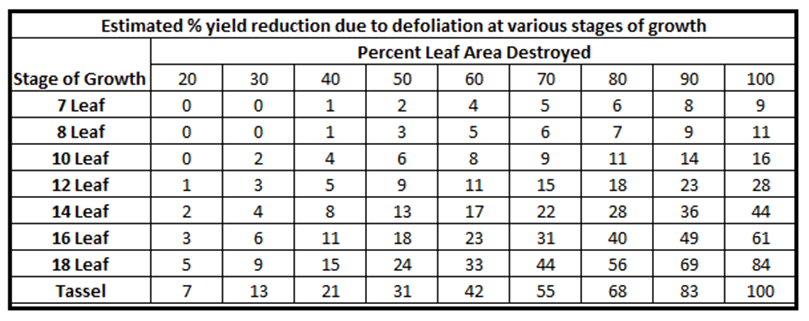Hail decision guide for corn
BackAssess your stands
In order to achieve an assessment it is important to complete plant counts of damaged plants in the same way plant establishment is assessed. Check several areas of a field, as hail damage can vary greatly throughout a field.
Prior to the corn reaching a height of 20 cm, the growing point remains protected below the ground surface and stand losses are less likely. However, with severe hail, plants can be damaged to the point that death is a result. If time permits, observations should be made 7-10 days following the damage for accurate conclusions.
If the growing point is present above ground you should always check for damage. Healthy growing points are white and firm. Injured growing points are soft and in time, will begin to turn brown similar to frost damaged plants. If observations are made immediately following a hailstorm, damaged plants can be overlooked. Be conscious of bruises on the stalks of small plants.
Estimating yield reductions due to stand reduction through the 10th actual leaf stage can be calculated utilising Table 1. When considering a replant situation it is also important to consider planting dates as they relate to potential yields. For example, it may be beneficial to leave a stand reduced to 45,000 plants per ha vs. replanting on 31 Dec to establish a stand of 75,000 plants per ha. Other factors to consider when assessing crops include:
- Gaps and skips have a negative effect
- Tables relate to stand reductions during the vegetative stages
- Consider the hybrid’s ability to flex ear size, or yield at low populations
- Weed control can negatively affect final yields

Table 1
Source: USA National Crop Insurance Association and the Crop Insurance Research Bureau, Inc.
Estimating leaf loss
Visually estimating the percentage of leaf area loss takes practice and experience. The amount of leaf loss is usually over-estimated. In order to estimate losses accurately you can assess individual leaves of the corn plant and then compile an average leaf area loss for the plant. Another method is to visually estimate losses by observing whole plants individually. This method requires more practice to accurately estimate leaf loss. Smaller corn can handle significant leaf loss without much yield loss because it can quickly re-grow new leaves. Even at the 10-leaf stage, only about 25 per cent of the plant’s eventual leaf area has been unfurled.
It is important to determine the stage of growth the crop was at when the damage actually occurred. Once this has been determined, use Table 2 to calculate yield losses. Remember, corn will add a new leaf every two to three days with normal weather conditions.

Table 2
Source: USA National Hail Insurance Association
STALK BRUISING AND BREAKAGE
Stalks are damaged most from the time corn is knee-high until it begins to tassel. After tasseling, corn stalks become more rigid and are less susceptible to bruising and breakage. If a plant survives stalk damage, it typically will produce near-normal yields, but it will be at greater risk for stalk lodging before harvest. Judging losses prior to harvest is difficult.
EAR AND KERNEL DAMAGE
Ears are particularly susceptible to hail damage from the blister to dough stage. To assess, estimate the percent of damaged kernels.
WEEDS CAN THREATEN CROP RECOVERY
With reduced stands and an open crop canopy, weed growth can be rapid. If cultivation is possible it may be the best option. If herbicide weed control programs are to be implemented, allow time for the crop to resume growth prior to making applications.
CORN LEAF TIE-UP
Leaf tie-up can be a common occurrence as emerging corn leaves get tied-up by the damaged older leaves. In most cases plants eventually break loose and survive; however, in severe cases death may be the result. If leaves do not break free easily, mechanical options have been attempted with limited success. Dry and windy weather usually is the best cure for this situation.
REPLANTING OPTIONS
If replanting becomes your only alternative consider your options carefully. It is extremely important to base your decisions upon economics rather than emotions at this stage.
Consider the following issues:
- Alternative crops
- Rotation restrictions due to herbicide activity
- Insurance coverage
- Replanting costs and potential returns
Contact your local Pioneer Seeds representative to assist with paddock assessments in the event of storm damage.
CN0623-10A
Your seed is backed by
local experience
With dedicated and highly skilled team members located throughout Australia you can be sure of accessing the best local knowledge to help you maximise your investment in Pioneer® brand hybrid seed. Get in touch with your local Territory Sales Manager or Farm Services Consultant today.
